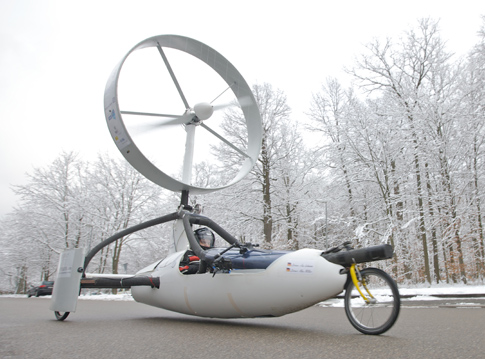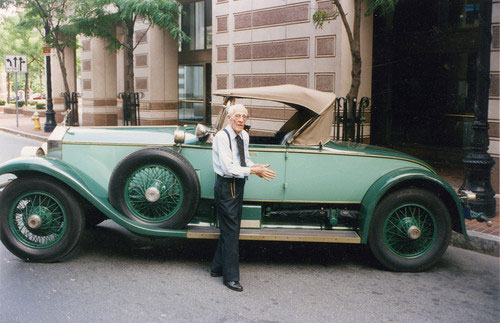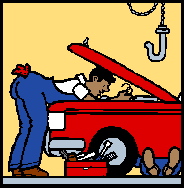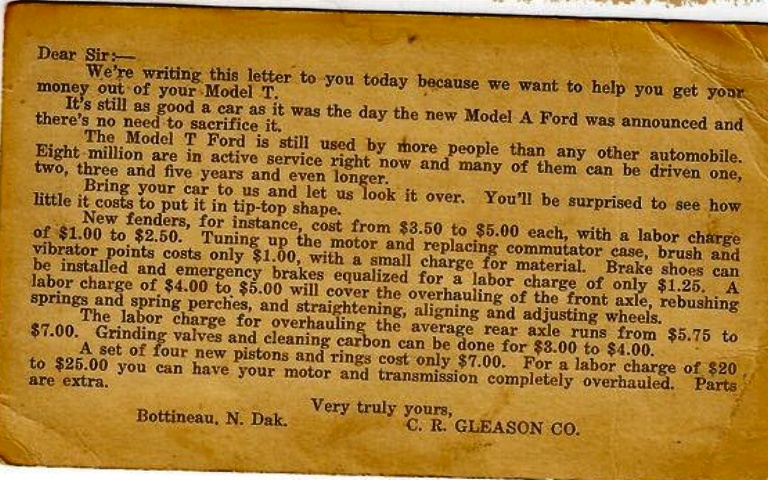The Last Thunderbird
Marking the end of an era, the last Thunderbird rolled off the assembly line
in Lorain, Ohio at 7:35 p.m. on Thursday, September 4, 1997. The T-Bird, first
produced in 1955 has suffered from poor sales in recent years and was
discontinued. The last car was driven off the line by Billy Jones, a retired
worker who spent 37 years at the Lorain plant. The car was donated to a
Thunderbird Club according to Ford officials. (Cars and Parts magazine 1997)

Would you like to win a bet
with that know it all car guy?
Any color you want as long as it
is black. All model T's were black.
For many years this legend has been kept alive by
countless thousands of carnuts, BUT, tis not true. Actually you could not even
get a black Model T in 1908.
Truth is that the 1909 Model T's, first introduced in l908, were painted red,
gray or green with the gray or green cars having black trim and red striping.

A short history of Route 66
Route 66 was christened in 1926 as
the "Main Street of America" beginning in Chicago and terminating in Los
Angeles. The road was mostly constructed under the New Deal work relief
program following the big economy crash of 1932, providing employment for
thousands of unemployed Americans. After completion it also provided
extensive economic boost to the communities along the way. Tourist courts,
diners, motels and gas stations seemed to appear overnight to capture the
dollars of those passing by.
In the 1930's Route 66 saw
thousands of families going to and fleeing from the "Dust Bowl" prairies of the
mid-west. In the 1940's it was filled with troop convoys bound for war.
In the late 1940's and 1950's it was the most popular highway in America for
tourists out to see the country.
Route 66 extends across 8 states,
following the natural topography rather than removing obstacles. The
roadside scenery is like a movie with the scenes changing by the minute.
Route 66 represented the
transition from rural roads that seldom linked into a continuous byway to the
Interstate system created under the Eisenhower presidency, when a system of
divided interstate highways was began. Unfortunately Route 66 was largely
displaced, removed and replaced by Interstate 40. While the Interstate
provided faster and safer travel it spelled the death of a majority of the
roadside businesses along Route 66.
Among the immigrants from the cold
upper mid-west who sought warmer climates in the Southwest was Robert Troop, a
Pennsylvanian, former Marine Captain and pianist for the Tommy Dorsey band.
Recorded by Nat King Cole and released in 1946, Robert Troop's "Get your kicks
on Route 66" became an instant hit and remains so to this day.

74 Miles - A bit over an
hours drive.
73.3 miles - The edge of
Space
These days, using the interstate
we can travel to Detroit, Muskegon, Mount Pleasant, Saginaw or Kalamazoo in
about an hour. These cities are about 70 or so miles from Lansing.
If you were an astronaut you would
reach the edge of space in
about 8.5 minutes in the Space Shuttle going from
zero to 17,000 miles per hour.

Seat Belts and other firsts.
1959 Nils Bohlin
modified an aircraft lap belt and came up with the first three point seat belt
which first appeared in a Volvo.
1901 Oldsmobile
unveils the first speedometer.
1920 Detroit hangs the
first three color stoplight.
1949 Nash autos
featured factory seat belts.
1952 The concept of
air bags was conceived.
1963 Some Volvos
were sold with the three point front seat belts.
1966 Crash test
dummies replaced cadavers, chimps and hogs.
1968 Federal law
required all new cars be equipped with seat belts.
( with the annoying feature that the car would not start unless the belts were
buckled.)
1974 The
seat belt no start feature was repealed by Congress.
1981
Only 11 percent of drivers were using seat belts.
1984 New
York became the first state to mandate seat belt use.
1995 All
states but New Hampshire have broad seat belt laws.
1998 All
new autos must have dual front seat air bags.

Ever wonder how the Gilmore Car museum's Diner
got the name, "George and Sally's Blue Moon Diner?"
Gilmore Car museum's Blue Moon Diner arrived there after a 790
mile trip from Meridian, Connecticut. The diner was built in 1941 by the
Paterson Vehicle Company of Patterson, New Jersey. It served as "Joe's Diner",
later becoming Gina's Diner and was the Blue Moon diner when it closed it's
doors in 1997.
Gilmore has honored local residents George and Sally
Turner, whose generous gift started the Diner project, by naming the diner
"George & Sally's Blue Moon Diner".

126 MPH on NO fuel whatsoever!!!!
Ultimate "Green" car land speed record set in March 2009 on a
dry lakebed in California, 126.2 MPH on wind power alone, beating the old
record by more than 10 mph. The vehicle, appropriately called "Greenbird"
is a three wheeled , 1,323 pound, carbon fiber creation of an English engineer,
Richard Jenkins with financing and technical assistance from Ecotricity,
England's largest private green electricity provider. Greenbird uses a
solid vertical sail - shaped like an airplane wing - to capture the wind.
The design enables the craft to travel at up top five times the speed of the
actual wind.
For some great photos and detailed engineering data click on
their website.
http://www.greenbird.co.uk/about-the-greenbird
@@@@@@@@@@@@@@@@@@@@@@@@@@@@@@@@@@@@@@@@@@@@@@@@@@@@@@@@@@@@@@@@@@@@@@@@@@@@@@@@@@@@@@@@@@@@@@@@@@@@@@@@
No fuel here either. Just the wind. But not as fast, only
15 mph and a little weird.

Read all about it on their website,
click here.
@@@@@@@@@@@@@@@@@@@@@@@@@@@@@@@@@@@@@@@@@@@@@@@@@@@@@@@@@@@@@@@@@@@@@@@@@@@@@@@@@@@@@@@@@@@@@@@@@@@@@@@@
So you think you have
owned your car for a long time?

Allen Swift (Springfield, MA.) received this 1928
Rolls-Royce Picadilly P1 Roadster from his father, brand
new - as
a graduation gift in 1928.
He
drove it up until his death last year
at the age of 102!!!
He was the oldest living owner of a car from new. Just thought you'd
like to see it. He donated it to a Springfield museum after his death.
It has 170,000 miles on it, still runs like a Swiss watch, dead silent
at any speed and is in perfect cosmetic condition. (82
years)
@@@@@@@@@@@@@@@@@@@@@@@@@@@@@@@@@@@@@@@@@@@@@@@@@@@@@@@@@@@@@@@@@@@@@@@@@
So you think driving is a
leading cause of deaths?
Twenty
Three ways to die!!
and your
odds for each.
@@@@@@@@@@@@@@@@@@@@@@@@@@@@@@@@@@@@@@@@@@@@@@@@@@@@@@@@@@@@@@@@@@@@@@@@@@@@@@@@@@@@@@@@@@@@@
A collection of Tid-Bits gleaned from various
sources.

Beatle Mania
Love the
Beatles?
Did you know that Adolph Hitler
was actually responsible?
Well, not the musical group but
the Kafer , (German word for Beetle) which became known as the "Peoples Car" aka
the Volkswagen.
In 1935 Hitler enlisted the
talents of Ferdinand Porsche to design and begin production of a small,
inexpensive car. Ferdinand designed and built a prototype and at the
Berlin Auto Show on February 15, 1936, Hitler proclaimed that millions will soon
drive Volkswagens. Sixteen million vehicles later the last German built
Beetle rolled off the assembly line in 1978.
For more information about the
history of the Beetle try
Wickipedia's web
page..
Hate those Parking Meters!!!!
Well it's not the parking meter but the parking ticket.
Anyway, who should we blame?
A Lawyer of course.
On May 28, 1938 Oklahoma Lawyer and newspaper publisher, Carl
Magee patented the parking meter. They were first deployed in 1935 in
Oklahoma City to deter people from parking all day in front of shops and
businesses. His nickel eating meters overcame that problem for sure.
They idea spread quickly and by 1941 there were 140,000 in use and today
probably millions. They have even evolved into digital electronic devices
that you can feed with a call from your cell phone.
If you want to install one in front of your house or in your den
you can buy one at the Dayton Cultural Center's Gift Shop at the Biltmore
Towers, 216 N. Main St.
@@@@@@@@@@@@@@@@@@@@@@@@@@@@@@@@@@@@@@@@@@@@@@@@@@@@@@@@@@@@@@@@@@@@@@@@@@@@@@@@@@@@@@@@@@@@@@
License Plates, some interesting facts.
License plates have been around since New York mandated
automobile licensing in 1901. They did not issue a license plate so owners
cobbled together their own, often attaching metal numbers designed for house
fronts to leather backings.
Early state issued plates tended to have enameled porcelain
surfaces and by World War I plates that weighed as much as a pound were being
stamped from heavy steel.
When steel conservation took hold during WW II multi-year
plates designed to accept small metal date tabs appeared, and some states even
turned to plates made of heavy cardboard or wood pulp derivatives.
Illinois based a substance on homegrown soybeans – goats
found them particularly tasty – and Louisiana derived one from sugar cane.
After the war aluminum was briefly in vogue but steel ultimately prevailed. In
Michigan metal tabs were issued into the 60’s.
In 1917 Arizona branded its plate with a steer’s head to
promote beef sales. Idaho surrounded its numbers with, what else, an outline of
a potato. Idaho’s current slogan, “Famous Potatoes” has been in use for over
50 years.
In 1941 New Mexico began inviting tourists to the “Land of
Enchantment” with a Native American Sun Sign and is still in use today after
nine decades. Wyoming’s Western bronco rider has remained in the saddle even
longer, he mounted up in 1936.
People have always nailed their expired plates up in barns
and garages and even used them to patch holes in things, like their cars.
Collectors have blossomed in the baby boomer age; some have thousands displayed
in their man caves (ultra-garages).
Prices range from a few dollars for fairly recent plates to
plates from the fifties or earlier are about $25. The cost curve gets much
steeper at the high end and a few especially rate plates have reached the
$10,000 range.
**Excerpted from American Heritage Magazine, April/May 2007
From CBS News. Delaware plates…
Delaware, it seems, has a cult fascination with low-digit
license plates - a fascination that translates into lots of dollars… but very
little sense.
Delawareans, especially natives, are familiar with the pull
of the black and white porcelain plates, pestering the Division of Motor
Vehicles to see if any are available, or resorting to auctions or Web sites
where a three-digit tag can sell for $80,000.
It all started over a century ago, when Delaware first started issuing plates -
in numerical order. The wealthy people who got their cars first go the lowest
numbers - and a status symbol was born.
Today, plate number “1” is reserved for the governor, “2” is for the lieutenant
governor and “3” for the secretary of state. All the rest can be bought and sold
on the open market. Plates with three and four digits often sell for thousands
of dollars. A two digit plate can sell for tens of thousands.
The Fuscos are a family of commercial real estate brokers who have been
collecting plates for 20 years.
“It all started back when my grandfather purchased number ‘9,’” says Frank
Fusco. “That's when the hype began.”
Fusco says his grandfather paid nearly $200,000 for that tag back in 1994. They
now own 17 plates valued at over $3 million.
At a special auction for the number “6,” the Fuscos are contenders, along with
investment groups and Tim Ayres, a wealthy publisher. Ayres already owns number
“11” and is betting on the bankability of number “6.”
“I think it would be a good investment, I really do," says Ayres.
In the end, plate number “11” goes to the Fuscos for a staggering $675,000.
View a gallery of Delaware Plates.
Click Here
The oldest
dealerships? Michigan is #2.
**
Based on families and dealerships that have registered with the NADA for having
been in business for 100 years or more.
1847 -W.Hare and sons,
Noblesville, Indiana
1852 - Shaefer & Bierlein,
Inc., Frankenmuth, Mi.
**Car
and Driver Magazine, Feb 2009.
@@@@@@@@@@@@@@@@@@@@@@@@@@@@@@@@@@@@@@@@@@@
Getting
your car fixed in 1928


@@@@@@@@@@@@@@@@@@@@@@@@@@@@@@@@@@@@@@@@@@@@@@@@@@@@@@@@@
Who
Invented -
Cruise Control
From Hemmings Feb
2008.
Credit for the
development of cruise control as we know it now goes to a remarkable individual
named Ralph Teetor, born in Hagerstown, Indiana in 1890. He was
blinded at
age five when a knife slipped while trying to pry open a drawer.
Undeterred, Teetor built his first car when he was but 12 years old and went on
to head his family owned business, which became known as Perfect Circle, the
piston-ring manufacturer.
Teetor was an
inventor since childhood, and in 1945, received the first patent for an
automotive speed control device. Legend has it that he got the idea while
riding with his lawyer who annoyingly speeded up and slowed down in time with
his conversations.
Teetor was well
ahead of his time. In most of the county, the device variously known as
Speedostat or Pressomatic, among other names, did not become useful until
interstate highways came into wide existence in the late 1950's.
When it first
appeared as an option on the 1958 Chrysler Windsor, New Yorker and Imperial
models, cruise control, as it eventually was commonly called was considered the
ultimate luxury, right up there with air conditioning.
Cadillac began
offering it across the board in 1960, followed by other GM lines although it was
not a GM product. If you looked at the casting it read Perfect Circle. So
Teetor probably received a royalty on every one.
Teetor died in
1982 at the age of 91 and is a member of the Automotive Hall of Fame in
Dearborn.
@@@@@@@@@@@@@@
Electric Cars
No it was not the
Japanese!!
Between 1832 and 1839
(the exact year is uncertain), Robert Anderson of Scotland invented the first
crude electric carriage. A small-scale electric car was designed by
Professor Stratingh of Groningen, Holland, and built by his assistant
Christopher Becker in 1835. Practical and more successful electric road
vehicles were invented by both American Thomas Davenport and Scotsmen Robert
Davidson around 1842. Both inventors were the first to use non-rechargeable
electric cells. Frenchmen Gaston Plante invented a better storage battery in
1865 and his fellow countrymen Camille Faure improved the storage battery in
1881. This improved-capacity storage battery paved the way for electric vehicles
to flourish.
France and Great Britain were the first
nations to support the widespread development of electric vehicles in the late
1800s. In 1899, a Belgian built electric racing car called "La Jamais Contente"
set a world record for land speed - 68 mph - designed by Camille Jénatzy.
It was not until 1895 that Americans began to
devote attention to electric vehicles after an electric tricycle was built by A.
L. Ryker and William Morrison built a six-passenger wagon both in 1891. Many
innovations followed and interest in motor vehicles increased greatly in the
late 1890s and early 1900s. In 1897, the first commercial application was
established as a fleet of New York City
taxis
built by the Electric Carriage and Wagon Company of Philadelphia.
 The
early electric vehicles, such as the 1902 Wood's Phaeton (top image), were
little more than electrified horseless carriages and surreys. The Phaeton had a
range of 18 miles, a top speed of 14 mph and cost $2,000. Later in 1916, Woods
invented a hybrid car that had both an internal combustion engine and an
electric motor.
The
early electric vehicles, such as the 1902 Wood's Phaeton (top image), were
little more than electrified horseless carriages and surreys. The Phaeton had a
range of 18 miles, a top speed of 14 mph and cost $2,000. Later in 1916, Woods
invented a hybrid car that had both an internal combustion engine and an
electric motor.
 By
the turn of the century, America was prosperous and cars, now available in
steam, electric, or gasoline versions, were becoming more popular. The years
1899 and 1900 were the high point of electric cars in America, as they outsold
all other types of cars. Electric vehicles had many advantages over their
competitors in the early 1900s. They did not have the vibration, smell, and
noise associated with
gasoline cars.
Changing gears on gasoline cars was the most difficult part of driving, while
electric vehicles did not require gear changes. While
steam-powered cars also had no gear shifting, they suffered from long
start-up times of up to 45 minutes on cold mornings. The steam cars had less
range before needing water than an electric's range on a single charge. The only
good roads of the period were in town, causing most travel to be local
commuting, a perfect situation for electric vehicles, since their range was
limited. The electric vehicle was the preferred choice of many because it did
not require the manual effort to start, as with the hand crank on gasoline
vehicles, and there was no wrestling with a gear shifter.
By
the turn of the century, America was prosperous and cars, now available in
steam, electric, or gasoline versions, were becoming more popular. The years
1899 and 1900 were the high point of electric cars in America, as they outsold
all other types of cars. Electric vehicles had many advantages over their
competitors in the early 1900s. They did not have the vibration, smell, and
noise associated with
gasoline cars.
Changing gears on gasoline cars was the most difficult part of driving, while
electric vehicles did not require gear changes. While
steam-powered cars also had no gear shifting, they suffered from long
start-up times of up to 45 minutes on cold mornings. The steam cars had less
range before needing water than an electric's range on a single charge. The only
good roads of the period were in town, causing most travel to be local
commuting, a perfect situation for electric vehicles, since their range was
limited. The electric vehicle was the preferred choice of many because it did
not require the manual effort to start, as with the hand crank on gasoline
vehicles, and there was no wrestling with a gear shifter.
While basic electric cars cost under $1,000,
most early electric vehicles were ornate, massive carriages designed for the
upper class. They had fancy interiors, with expensive materials, and averaged
$3,000 by 1910. Electric vehicles enjoyed success into the 1920s with production
peaking in 1912.
The decline of the electric vehicle was
brought about by several major developments:






 The
Importance of Gottlieb Daimler
The
Importance of Gottlieb Daimler